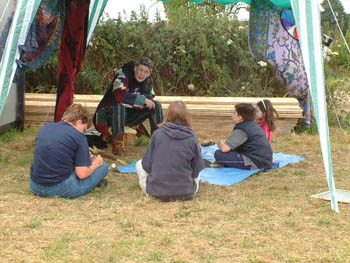The 2001 Season
Week 2 by Amanda Clarke |
Day 8: 16th July
Work in the south-east corner of the site has uncovered one of the site’s more enigmatic features:
a circular cut containing an east-west alignment of mortared flint which divided the cut into two
roughly equal halves. Excavation of this pit has shown that the northern half contained some
loose flints and rubble and a small amount of painted wall plaster and mortar. The southern
half was full of crushed mortar and painted wall plaster. The linear alignment of flint has
been recorded, photographed and excavated along with the fills of the pit and excavation
continues.
| The pit has not yet been bottomed. Tentative suggestions for use are as a structural
support for a pillar or post to be associated with buildings outside our excavation trench to
the south. |
| 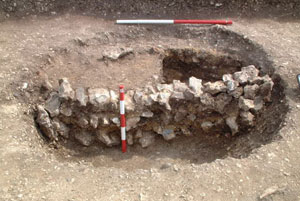 |
Day 9: 17th July
Although we believed we completed the excavation of all Victorian trenches on site in 1998, this
week we have further defined a remnant of Victorian trench which contains a large amount of
re-deposited Roman material, mainly pot. This feature is reminiscent of the Victorian rubbish
pit excavated in 1997 in the north east area of the site. In the trench amongst the discarded
Roman pot were several Victorian items. The Victorians were obviously re-burying the discarded
Roman finds within their trenches. So far over 6 buckets of Roman pottery sherds have so far
been removed from this fill. |
| 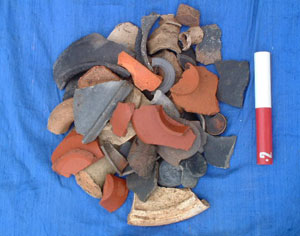 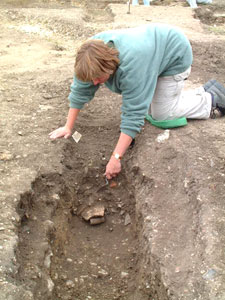
|
Day 10: 18th July
The blacksmith’s hearth in Building 9 is finally under excavation. This hearth has been
with us since 1996 and it will be like losing an old friend. The hearth has been dated
by archaeo-magnetism to the fourth century, sampled for soil micro-morphology, photographed,
described and drawn. It is now being excavated and appears to have had 2 main and 2 minor
structural phases.
Work has also begun on disentangling the latest phase of House 1. Although constructed
into an extensive spread of yellow clay, it is also apparent that subsequent to the construction
of the building, deposits of yellow clay were placed externally to the walls. Much time is
being spent examining the nature of the building foundations and determining the sequence
of excavation. Features cut into the yellow clay are being examined, a series of small pits
and post holes outside House 1 and running parallel to it’s outer wall to the north are
being examined.
Inside the house, a small pit cut into the corner of Room 5 has been excavated. This
pit was found to contain an entire pot deliberately buried as part of a construction ritual.
This pot is flint tempered Silchester Ware, which has a date of 20/10BC to 60AD.
|
It is possible
that this may not indicate the date of deposition of the pot; the pot may have been curated
for a number of years before being burned prior to the construction of the latest phase of House
1. |
| | 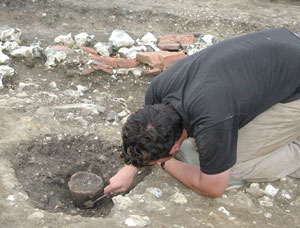 |
Day 11: 19th July
The last week has been spent trying to understand the sequence of layers along the east –
west street. There are still deposits along the street front relating to the late Roman
occupation and these are being removed first. The objective is to understand the relationship
of the latest phase of House 1 cut into the yellow clay with the deposits along the east-west
street frontage. This is quite a complicated exercise disentangling all the layers and
stratigraphy linking House 1 to external deposits.
|
Removal of large layers is not without
excitements; today for example a pair of tweezers and a pair of nail cleaners (both of
copper alloy) were found in the soils overlying the yellow clay: someone’s personal hygiene kit.
|
| 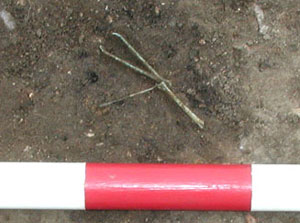 |
Outside House 1 in the north-west area of the site work has restarted today on the early
Roman well, the excavation of which commenced last year. The well has been covered over for
the winter. The water standing in it has been pumped out and the slumped material from the
sides has been removed.
Also cut into the gravels in the north-west area of the site is another pit, the upper levels
of which were excavated in 2000 and consisted of a mass of dumped animal bone. Removal of
this material and the clay beneath has revealed what may be an early well. A charcoal
filled deposit in the top of this early feature is producing flint-tempered pottery of the
first century AD. Outside House 1 to the south, excavation continues of a variety of pits
and cuts which may be associated with the life of the late Roman buildings fronting onto
the north-south street. Surrounding these cess and rubbish pits are dark soils full of
animal bone and other domestic rubbish. Excavation of a cess-pit in this area began in
2000 has revealed the dis-articulated skeleton of at least 2 dogs. Environmental sampling
of the layers containing these dogs has produced mineralised material in the form of
pips and seeds, material which has passed through the human digestive system. Another
pit which last year produced an entire articulated dog skeleton has produced not only
vast quantities of animal bone: dog, cat and cow, but also some bones from a human infant.
It is possible that on death neo-natal children were buried with dogs or cats.
|





